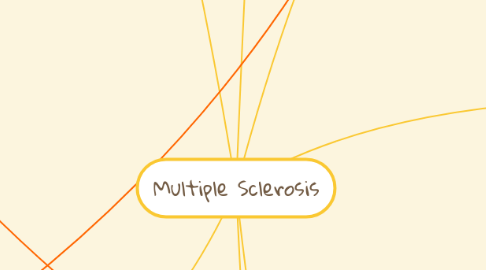
1. Treatments
1.1. There is no current cure for multiple sclerosis
1.2. For MS attacks
1.2.1. Corticosteroids
1.2.1.1. Oral prednisone
1.2.1.2. Intravenous methylprednisolone
1.2.1.3. Reduces nerve inflammation
1.2.1.4. Side effects from corticosteroids
1.2.1.4.1. Insomnia
1.2.1.4.2. Increased blood pressure
1.2.1.4.3. Fluid retention
1.2.2. Plasmapheresis
1.2.2.1. Plasma exchange
1.2.2.2. Removes and separates plasma from blood cells. Blood cells are mixed with albumin ad put back in body.
1.2.2.3. Used for new, severe symptoms that don't respond to steriods
1.3. To modify progression
1.3.1. Primary progressive MS
1.3.1.1. Ocrelizumab (Ocrevus)
1.3.1.1.1. Slows worsening of disability
1.3.2. Relapsing-remitting MS
1.3.2.1. Beta interferons
1.3.2.1.1. Most common medication to treat MS
1.3.2.1.2. Reduce frequency and severity of relapses
1.3.2.2. Ocrelizumab (Ocrevus)
1.3.2.2.1. humanized immunoglobulin antibody medication
1.3.2.2.2. Treats both relapse-remitting MS and primary progressive MS
1.3.2.2.3. Reduces relapse rate
1.3.2.3. Glatiramer acetate (Copaxone)
1.3.2.3.1. Blocks immune system's attack on myelin
1.4. For MS s/sx
1.4.1. Physical therapy
1.4.1.1. Helps manage leg weakness and other gait problems often associated with MS
1.4.2. Muscle relaxants
1.4.2.1. baclofen (Lioresal) and tizanidine (Zanaflex)
1.4.2.2. painful or uncontrollable muscle stiffness or spasms, particularly in your legs
1.4.3. Alternative medicine
1.4.3.1. Exercise, meditation, yoga, massage, eating a healthier diet, acupuncture and relaxation techniques
2. Risk factors/Etiology
2.1. Certain infections
2.1.1. Epstein-Barr virus
2.2. Age
2.2.1. MS can occur at any age
2.2.2. Most commonly affects people between the ages of 15 and 60
2.3. Climate
2.3.1. MS is more common in countries with temperate climates
2.3.2. United States, New Zealand, southeastern Australia and Europe.
2.4. Sex
2.4.1. Women are twice as likely as men to develop MS
2.5. Previous or current autoimmune disease
2.5.1. Thyroid disease
2.5.2. Type 1 diabetes
2.5.3. Inflammatory bowel disease
2.6. Family history
2.7. Race
2.7.1. White people, particularly those of Northern European descent, are at highest risk of developing MS
2.7.2. Asian, African or Native American descent have the lowest risk.
3. Pathogenesis
3.1. Many people with MS have relapsing-remitting disease course
3.1.1. Periods of new symptoms called relapses, develop over days or weeks
3.1.2. Relapses are followed by quiet periods of disease remission that can last months or even years
3.1.3. Secondary-progressive MS
3.1.3.1. Development of a steady progression of symptoms, with or without periods of remission
3.1.3.2. Happens to 60-70% of people with relapsing-remitting MS
3.2. The cause of multiple sclerosis is unknown
3.2.1. It's considered an autoimmune disease
3.2.1.1. The body's immune system attacks its own tissues
3.2.1.2. This immune system malfunction destroys myelin
3.2.1.2.1. The fatty substance that coats and protects nerve fibers in the brain and spinal cord
3.3. It is not clear why MS develops in some people and not others
3.3.1. Thought to be a combination of genetics and environmental factors
4. Incidence/Prevalence
4.1. Affects about than 2.5 million worldwide
4.2. > 400,000 US cases per year
4.3. Rates of MS are higher farther away from the equator
4.4. The ratio of women with MS to men with MS is 2 : 1
4.5. If you have a parent or sibling with MS, you have a 1 - 3% chance of developing it
4.6. People with ... are at a slightly increased risk for MS
4.6.1. Type 1 diabetes
4.6.2. Thyroid disease
4.6.3. Inflammatory bowel disease
5. Diagnostics
5.1. Blood tests
5.2. Lumbar puncture
5.2.1. Fluid sample can show abnormalities in antibodies associated with MS
5.2.2. Rules out infections and conditions with symptoms similar to MS
5.3. MRI
5.3.1. Reveals MS lesion areas on brain and spinal cord
5.4. Evoked potential tests
5.4.1. Record electrical signals produced by nervous system in response to stimuli
5.4.2. Tests can use visual or electrical stimuli
5.5. Differential diagnosis
5.5.1. There are no specific tests to diagnose MS, instead other conditions are ruled out
6. Clinical Manifestations - Signs & Symptoms
6.1. Fatigue
6.2. Tingling or pain in parts of body
6.3. Prolonged double vision
6.4. Electric-like shock sensations
6.4.1. Happens with sudden neck movements
6.4.2. Lhermitte sign
6.4.2.1. Bending the neck forward
6.5. Slurred speech
6.6. Partial or complete loss of vision
6.6.1. Usually in one eye at a time
6.6.2. Pain during eye movement
